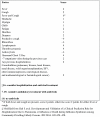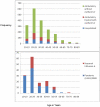Hospital triage system for adult patients using an influenza-like illness scoring system during the 2009 pandemic--Mexico
- PMID: 20498718
- PMCID: PMC2871038
- DOI: 10.1371/journal.pone.0010658
Hospital triage system for adult patients using an influenza-like illness scoring system during the 2009 pandemic--Mexico
Abstract
Background: Pandemic influenza A (H1N1) virus emerged during 2009. To help clinicians triage adults with acute respiratory illness, a scoring system for influenza-like illness (ILI) was implemented at Hospital Civil de Guadalajara, Mexico.
Methods: A medical history, laboratory and radiology results were collected on emergency room (ER) patients with acute respiratory illness to calculate an ILI-score. Patients were evaluated for admission by their ILI-score and clinicians' assessment of risk for developing complications. Nasal and throat swabs were collected from intermediate and high-risk patients for influenza testing by RT-PCR. The disposition and ILI-score of those oseltamivir-treated versus untreated, clinical characteristics of 2009 pandemic influenza A (H1N1) patients versus test-negative patients were compared by Pearson's Chi(2), Fisher's Exact, and Wilcoxon rank-sum tests.
Results: Of 1840 ER patients, 230 were initially hospitalized (mean ILI-score = 15), and the rest were discharged, including 286 ambulatory patients given oseltamivir (median ILI-score = 11), and 1324 untreated (median ILI-score = 5). Fourteen (1%) untreated patients returned, and 3 were hospitalized on oseltamivir (median ILI-score = 19). Of 371 patients tested by RT-PCR, 104 (28%) had pandemic influenza and 42 (11%) had seasonal influenza A detected. Twenty (91%) of 22 imaged hospitalized pandemic influenza patients had bilateral infiltrates compared to 23 (38%) of 61 imaged hospital test-negative patients (p<0.001). One patient with confirmed pandemic influenza presented 6 days after symptom onset, required mechanical ventilation, and died.
Conclusions: The triaging system that used an ILI-score complimented clinicians' judgment of who needed oseltamivir and inpatient care and helped hospital staff manage a surge in demand for services.
Conflict of interest statement
Figures





Similar articles
-
Novel influenza A(H1N1) in a pediatric health care facility in New York City during the first wave of the 2009 pandemic.Arch Pediatr Adolesc Med. 2010 Jan;164(1):24-30. doi: 10.1001/archpediatrics.2009.259. Arch Pediatr Adolesc Med. 2010. PMID: 20048238
-
Identification, management, and clinical characteristics of hospitalized patients with influenza-like illness during the 2009 H1N1 influenza pandemic, Cook County, Illinois.Infect Control Hosp Epidemiol. 2011 Oct;32(10):998-1002. doi: 10.1086/661912. Epub 2011 Aug 30. Infect Control Hosp Epidemiol. 2011. PMID: 21931250
-
Using age, triage score, and disposition data from emergency department electronic records to improve Influenza-like illness surveillance.J Am Med Inform Assoc. 2015 May;22(3):688-96. doi: 10.1093/jamia/ocu002. Epub 2015 Feb 26. J Am Med Inform Assoc. 2015. PMID: 25725005 Free PMC article.
-
Evaluation of triage methods used to select patients with suspected pandemic influenza for hospital admission: cohort study.Health Technol Assess. 2010 Oct;14(46):173-236. doi: 10.3310/hta14460-03. Health Technol Assess. 2010. PMID: 20923612
-
Reducing occurrence and severity of pneumonia due to pandemic H1N1 2009 by early oseltamivir administration: a retrospective study in Mexico.PLoS One. 2011;6(7):e21838. doi: 10.1371/journal.pone.0021838. Epub 2011 Jul 8. PLoS One. 2011. PMID: 21760915 Free PMC article.
Cited by
-
Early detection of pandemic (H1N1) 2009, Bangladesh.Emerg Infect Dis. 2012 Jan;18(1):146-9. doi: 10.3201/eid1801.101996. Emerg Infect Dis. 2012. PMID: 22257637 Free PMC article.
-
Infection control management of patients with suspected highly infectious diseases in emergency departments: data from a survey in 41 facilities in 14 European countries.BMC Infect Dis. 2012 Jan 28;12:27. doi: 10.1186/1471-2334-12-27. BMC Infect Dis. 2012. PMID: 22284435 Free PMC article.
-
Google Flu Trends: correlation with emergency department influenza rates and crowding metrics.Clin Infect Dis. 2012 Feb 15;54(4):463-9. doi: 10.1093/cid/cir883. Epub 2012 Jan 8. Clin Infect Dis. 2012. PMID: 22230244 Free PMC article.
-
An analysis of 332 fatalities infected with pandemic 2009 influenza A (H1N1) in Argentina.PLoS One. 2012;7(4):e33670. doi: 10.1371/journal.pone.0033670. Epub 2012 Apr 10. PLoS One. 2012. PMID: 22506006 Free PMC article.
-
The Utility of Preliminary Patient Evaluation in a Febrile Respiratory Infectious Disease Unit outside the Emergency Department.J Korean Med Sci. 2017 Sep;32(9):1534-1541. doi: 10.3346/jkms.2017.32.9.1534. J Korean Med Sci. 2017. PMID: 28776351 Free PMC article.
References
-
- Thompson WW, Shay DK, Weintraub E, Brammer L, Bridges CB, et al. Influenza-associated hospitalizations in the United States. JAMA. 2004;292:1333–1340. - PubMed
-
- Nguyen-Van-Tam JS, Hampson AW. The epidemiology and clinical impact of pandemic influenza. Vaccine. 2003;2:1762–1768. - PubMed
-
- World Health OrganizationGlobal Influenza Programme. 2009. Pandemic influenza preparedness and response: a WHO guidance document. Accessed at: http://www.who.int/csr/disease/influenza/PIPGuidance09.pdf.
MeSH terms
LinkOut - more resources
Full Text Sources
Medical

